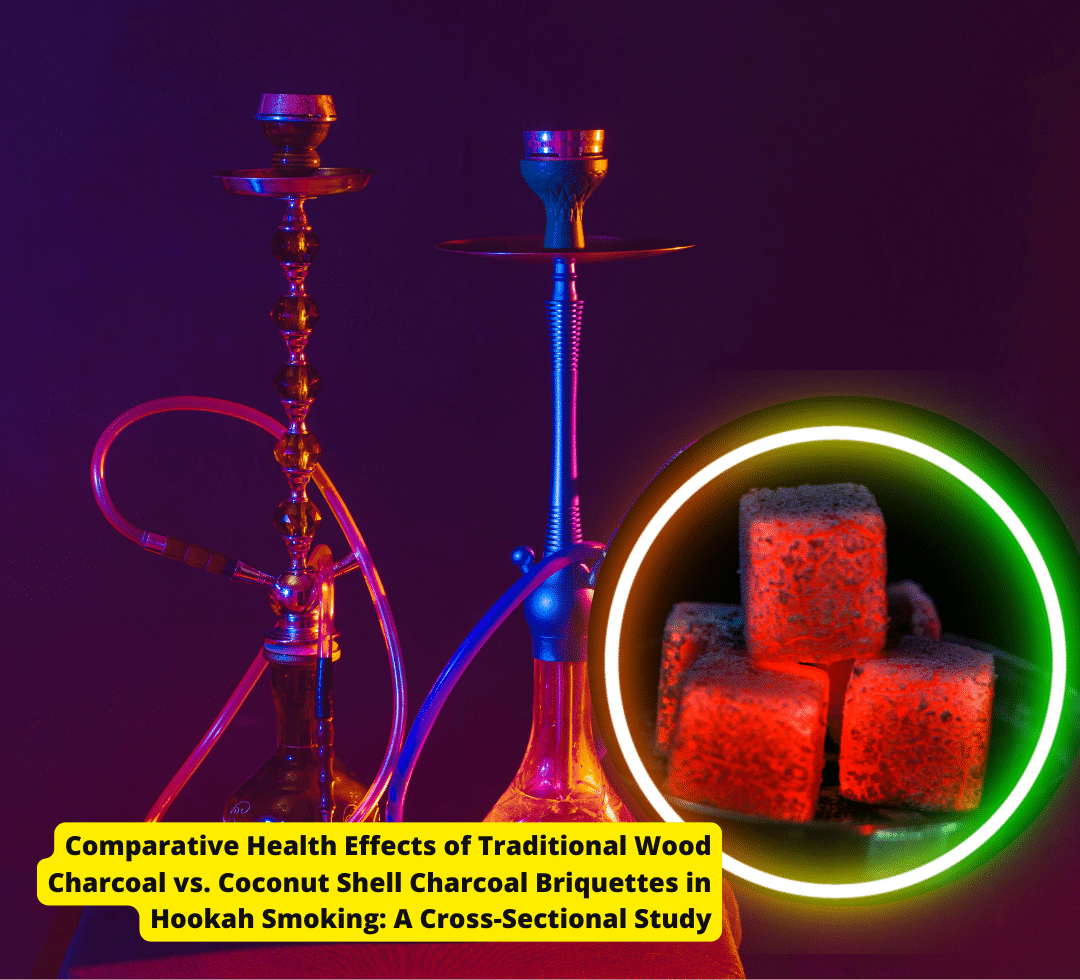Abstract
Authors: Greg Ryabtsev, et al.
This study investigates the impact of different charcoal types used in hookah smoking on general health, specifically focusing on end-tidal carbon monoxide (eCO) levels.
A cross-sectional study was conducted in Magelang, Central Java, comparing the eCO levels in participants smoking shisha using traditional wood charcoal versus coconut shell charcoal briquettes. A total of 126 healthy adult volunteers were divided equally into two groups based on the charcoal used.
The results revealed significantly higher eCO levels in participants using wood charcoal compared to those using coconut shell charcoal briquettes.
These findings highlight the influence of charcoal type on carbon monoxide exposure in hookah smokers and suggest the potential benefits of using cleaner-burning alternatives like coconut shell charcoal briquettes.
Keywords: Hookah, hookah charcoal, shisha charcoal, coconut shell charcoal briquettes

Introduction
Hookah smoking, also known as shisha, waterpipe, narghile, or hubble-bubble, is a method of tobacco consumption involving charcoal-heated air that passes through a bowl containing flavored tobacco and then through water before being inhaled. Originating from India, hookah use has spread globally, gaining popularity in the Middle East, Europe, North America, and Asia.
The perception that hookah smoking is less harmful than cigarette smoking is widespread but inaccurate. Prior research has demonstrated the adverse health impacts of hookah use, particularly on the cardiovascular and respiratory systems. However, the role of the heating source—charcoal—has received less attention. In traditional hookah practices, lump wood charcoal is placed directly on the tobacco, while modern practices often involve coconut shell charcoal briquettes designed for cleaner and more consistent combustion.
This study aims to evaluate the effects of different charcoal types on eCO levels among hookah users to better understand their impact on health.
Apparatus description
A hookah apparatus is composed of an upper and lower compartment connected by a pipe. On the upper part is located the bowl that contains tobacco leaves or molasses with flavors. On top of it is located the charcoal that heats the tobacco.
Below the bow is the long or short pipe that is connected to the vessel with water (but in some cases can be milk, coconut water, or even alcohol) that cools down the hot air and then connected with a flexible pipe to the end, which is used for inhaling.
The smoker is inhaling from one end of the pipe (usually the flexible pipe) by which he/she makes a vacuum in the upper part and the air is sucked into the bowl with tobacco though the hot charcoal.
There are a lot of different shapes, sizes and constructions of the hookahs. But the main idea is the same: to heat up air with charcoal, then put it through tobacco leaves, then cool down the air and inhale it.
Some studies reported that differences in pipe material affected the levels of carbon monoxide (CO) exposure, correlating the non-porous plastic hose with higher yields of CO compared to the more porous leather hose. As in another research called A Naturalistic Study of Carbon Monoxide, Heart Rate, Oxygen Saturation, and Perfusion Index in Hookah Lounge Patrons concludes that Hookah lounge smokers are exposed to high levels of CO that have the potential for detrimental health effects, as evidenced by rapid negative changes in physiological parameters.
The aim of this study was to evaluate and compare the increase in end tidal carbon monoxide (eCO) levels in the exhaled breath of smokers after smoking traditional shisha on wood charcoal compared to smoking hookah on coconut shell charcoal briquets.
Methods
Study design and participants
This was a cross-sectional study, which was done in Magelang, Central Java at the facility of the PT Coco Total Karbon Indonesia, the coconut shell charcoal briquettes manufacturer.
The study covers 126 volunteer smokers, 63 were smoking shisha on coconut charcoal briquettes with size cube 25, cube 26 mm, Platinum type, and 63 persons were smoking on lump wood charcoals (mangroves and coffee wood charcoal).
Background information regarding their age, gender, occupation, smoking habits, and illicit drug use, including alcohol, was taken prior to the study. People with a history of diabetes, asthma, or any other respiratory ailments were excluded from this study.
The data was collected by team of doctors from Magelang general hospital (RSU Magelang) from April 2025 to June 2025 and managed and analyzed by coconut charcoal expert Greg Ryabtsev.
During the study, the volunteers were smoking shisha for 45-90 minutes each on 25 or 26 mm cube charcoal briquettes (3 on the bowl head) and the second team was smoking on lump wood charcoal similar size to briquettes.
Study ethics
A formal permission from management of the charcoal factory was taken and informed consent from all volunteers was taken too.
Equipment and measurement variables
The equipment used for measuring end tidal Carbon monoxide level in exhaled air was Covita Bedfont Micro Plus Smokerlyzer Breath Monitor CO Analyzer (BedFont Instrument, UK, provided by PT Coco Total Karbon Indonesia).
Previously, it had been reported that smokerlyzer measurements of eCO correlate closely with blood carboxyhemoglobin concentration. The smokerlyzer measures exhaled Carbon monoxide levels in part per million (ppm).
The study subjects were asked to inhale deeply after shisha smoking, hold their breath for at least 10 seconds, and then exhale rapidly and forcefully intoa disposable mouthpiece of smokerlyzer.
Single measurement was taken every time ,and it was repeated only when the volunteer was unable to do it properly.
Statistical analysis
Data entry and analysis was done by using IBM Statistical Package for Social Sciences (SPSS) Version 31. Results were expressed in mean+/- SD.
One-way Anova was used to compare the mean of baseline eCO because the variance among all groups were not equal. Tamhane was used depending on sample distribution. Paired T Test was used for comparison between data from different intervals. A P value less than 0.05 was considered statistically significant.
Results
The mean age of volunteers was 34+/-2.2. 78% of the study population were office workers. 92% were males and 8% were females.
The baseline mean eCO value in wood charcoal smokers was 3.5 +/- 0.6 ppm; in coconut charcoal briquettes smokers, 27.7+/-4.9 ppm.
| Characteristic | Coconut Charcoal Group (n=63) | Wood Charcoal Group (n=63) |
| Mean Age (years) | 34.1 ± 2.2 | 33.9 ± 2.3 |
| Gender (Male %) | 91% | 93% |
| Office Workers (%) | 76% | 80% |
The baseline eCo levels were measured after 30 +/-5 minutes of the subject’s entrance in these venues. Table 1: The Mean eCO of all groups was compared by use of the Tamhane test. Comparisons among groups were highly significant (p <0.001). The difference between the eCo levels of wood charcoal smokers and coconut charcoal briquettes smokers was 24.2 ppm.
| Time Point | Coconut Charcoal | Wood Charcoal |
| Baseline (30 min) | 27.7 ± 4.9 | 3.5 ± 0.6 |
| After Smoking (90 min) | 30.2 ± 5.1 | 12.9 ± 5.3 |
| Mean Increase | 2.5 ± 1.3 | 9.41 ± 4.67 |
Mean difference of eCO Levels among different groups 30 minutes after entering the venue
eCo levels increased from baseline in all four groups after exposure to wood charcoal smoking and coconut charcoal briquettes smoking. The difference in eCO (eCO 90 minutes –eCO 30 minutes) in wood charcoal smokers was 9.41+/-4.67 (p < 0.001)

Discussion
The study findings suggest that while both types of charcoal used in hookah smoking lead to elevated eCO levels, coconut shell charcoal briquettes result in significantly lower CO exposure compared to lump wood charcoal. This supports the hypothesis that charcoal type significantly impacts toxic exposure during hookah smoking.
These findings are consistent with existing literature that highlights the harmful effects of carbon monoxide from hookah smoking. Additionally, the combustion of traditional wood charcoal is associated with higher emissions of particulate matter and heavy metals, including arsenic and cobalt, which contribute to respiratory and cardiovascular risks.
Limitations of this study include the use of a convenience sample and potential confounding variables such as individual smoking behaviors and environmental ventilation, which were not strictly controlled.
Conclusion
Both wood charcoal and coconut shell charcoal briquettes contribute to elevated eCO levels in hookah smokers. However, coconut shell charcoal briquettes result in lower carbon monoxide exposure, suggesting a safer alternative for heating in hookah use. These findings support initiatives promoting the use of cleaner-burning briquettes and call for regulatory measures against the use of high-emission traditional wood charcoal in hookah lounges.
Citations
Akhter S, et al. (2014). Comparison of end tidal carbon monoxide… Tob Induc Dis. 12(1):10.
Martinasek MP, et al. (2021). A Naturalistic Study of Carbon Monoxide… Respir Care. 66(2):269-274.
Qasim H, et al. (2019). The effects of hookah/waterpipe smoking… Environ Health Prev Med. 24(1):58.
Bou Fakhreddine HM, et al. (2014). The growing epidemic of water pipe smoking… Respir Med. 108(9):1241-53.
Jukema JB, et al. (2014). Waterpipe smoking: not necessarily less hazardous… Neth Heart J. 22(3):91-9.
Maziak W, et al. (2004). Tobacco smoking using a waterpipe… Tob Control. 13(4):327-33.
Hammal F, et al. (2008). A pleasure among friends… Tob Control. 17(2):e3.
Nakkash R, Khalil J. (2010). Health warning labelling practices… Tob Control. 19(3):235-9.
Khater AE, et al. (2008). Radiological hazards of Narghile smoking… J Environ Radioact. 99(12):1808-14.
Zahran FM, et al. (1985). Carboxyhemoglobin concentration… Br Med J. 291(6511):1768-70.
Inayatillah IR, et al. (2014). Kadar karbon monoksida udara ekspirasi… J Respir Indo. 34(4):180-90.
Septedjian E, et al. (2013). Phenolic compounds in waterpipe smoke… Nicotine Tob Res. 15(6):1107-12.



